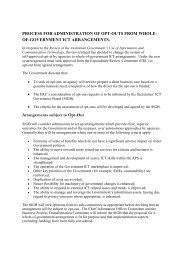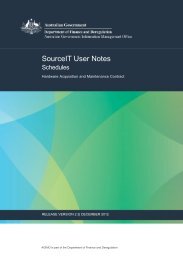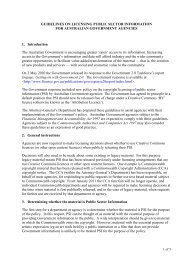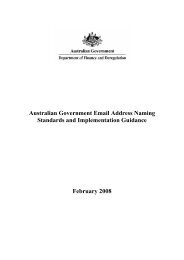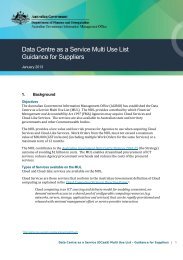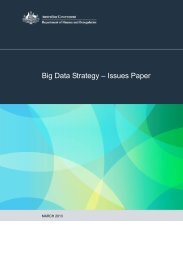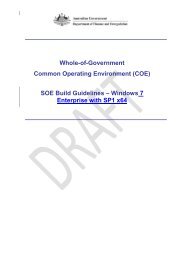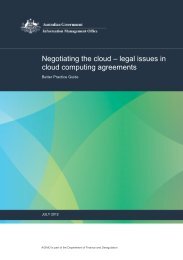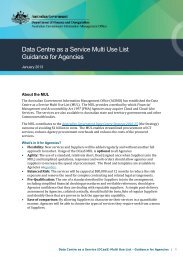Email Protective Marking Standard for the Australian Government
Email Protective Marking Standard for the Australian Government
Email Protective Marking Standard for the Australian Government
You also want an ePaper? Increase the reach of your titles
YUMPU automatically turns print PDFs into web optimized ePapers that Google loves.
2.4 NamespaceThe protective markings described in this <strong>Standard</strong> use <strong>the</strong> security classificationsystem defined in <strong>the</strong> <strong>Australian</strong> <strong>Government</strong> security classification system.The syntaxes defined in this <strong>Standard</strong> contain elements to convey this namespace. Thenamespace <strong>for</strong> this <strong>Standard</strong> is:gov.au• This namespace value does not necessarily reflect <strong>the</strong> email domain of <strong>the</strong> sendingand receiving parties. It is simply a short and convenient string that has been usedto differentiate this namespace from ano<strong>the</strong>r entity’s.• If an <strong>Australian</strong> State or Territory government agency wishes to use <strong>the</strong> Federal<strong>Government</strong> namespace and terms <strong>the</strong>n it can use <strong>the</strong> above. If <strong>the</strong> state agencywishes to define and use its own namespace and rules, <strong>the</strong>n it may do so provided ituses a different namespace value.2.5 Syntax of <strong>the</strong> <strong>Protective</strong> <strong>Marking</strong>This <strong>Standard</strong> specifies two ways in which <strong>the</strong> protective marking can be applied to anemail message: Subject Field <strong>Marking</strong> Internet Message Header Extension.The Internet Message Header Extension SHOULD be used in preference to <strong>the</strong> SubjectField <strong>Marking</strong> (see <strong>the</strong> Implementation Guide <strong>for</strong> fur<strong>the</strong>r in<strong>for</strong>mation).2.5.1 Subject Field <strong>Marking</strong>In this syntax <strong>the</strong> protective marking is placed in <strong>the</strong> Subject field of <strong>the</strong> message (RFC2822“Subject”).• This approach is <strong>the</strong> least sophisticated of <strong>the</strong> techniques and is purposely designed so thata human user can construct and interpret <strong>the</strong> protective marking without <strong>the</strong> need <strong>for</strong>additional tools. <strong>Email</strong> gateways should be able to translate <strong>the</strong> email’s subject betweeninternal and Internet <strong>for</strong>mats without any degradation. The syntax is sufficiently rich so anemail agent, or extensions <strong>the</strong>reof, can include or parse <strong>the</strong> protective marking in anautomated fashion. The overloading of <strong>the</strong> “Subject:” header could interfere with o<strong>the</strong>r usesof <strong>the</strong> Subject field. Fur<strong>the</strong>rmore, entry of this in<strong>for</strong>mation by a human is prone to error, andcould be easily misinterpreted by email systems. The approach is also included because it isbackwards compatible with all Internet email agents and systems.• Agencies SHOULD position <strong>the</strong> <strong>Protective</strong> <strong>Marking</strong> at <strong>the</strong> end of <strong>the</strong> Subject field.• Agencies SHOULD, where possible, implement mitigation strategies to minimise <strong>the</strong> risk of<strong>the</strong> <strong>Protective</strong> <strong>Marking</strong> being truncated from <strong>the</strong> end of <strong>the</strong> subject line.Note that during message generation and transport, o<strong>the</strong>r agents may manipulate <strong>the</strong> subject.9



